JSS University Mysore 2025
NAAC A+ Accredited| Ranked #24 in University Category by NIRF | Applications open for multiple UG & PG Programs
The Resonance Coaching Institute will release a detailed analysis of the NEET 2025 paper along with the expected cutoff. Aspirants who appear in the exam will be able to check the NEET 2025 analysis by resonance below. The expected NEET 2025 cutoff is likely to be on the higher side and is expected to be around 650 marks for MBBS govt. seat for the general category for All India Quota (AIQ).
This Story also Contains

With the help of NEET analysis & expected cut-off 2025 by Resonance, aspirants can know their probability of qualifying for the exam. Also, through NEET 2025 analysis & expected cutoff by Resonance, aspirants will get to know the level of difficulty of the exam, types of questions, and section-wise difficulty. NEET answer key 2025 by Resonance will also be released along with the analysis.
The education experts of Resonance prepare the analysis of the NEET exam. Aspirants can be highly benefited from it. Careers360 brings you a detailed NEET exam analysis and the expected cutoff which will help the students with their entrance preparations. Interested candidates can check here for complete details about the NEET cut-off analysis and expected cutoff by Resonance, including minimum qualifying percentiles, EET cut-off trends, etc.
NAAC A+ Accredited| Ranked #24 in University Category by NIRF | Applications open for multiple UG & PG Programs
To qualify the examination, candidates need to secure a minimum prescribed percentile. Resonance will declare the expected marks the candidate needs to score to qualify in the exam once the exam is over. The cutoff of NEET 2025 is expected to increase. National Testing Agency (NTA) will release the official NEET cut off marks only after the declaration of the NEET result 2025. The category-wise cut off percentile can be checked in the table below.
Category | Cut-off Percentile | Qualifying marks |
General | 50th | To be announced |
General-PH | 45th | To be announced |
SC/ST/OBC | 40th | To be announced |
SC/OBC-PH | 40th | To be announced |
ST-PH | 40th | To be announced |
The analysis of NEET 2025 by Resonance will be provided here, once available. Meanwhile, candidates can check the analysis of previous year's NEET UG exams to get an idea of the difficulty level and other important details.
As it is known to all the analysis and expected cutoff by Resonance for NEET 2024 was released after the conclusion of the entrance exam. Aspirants can go through the NEET analysis and expected cutoff which was given by Resonance.
Difficulty Level Analysis
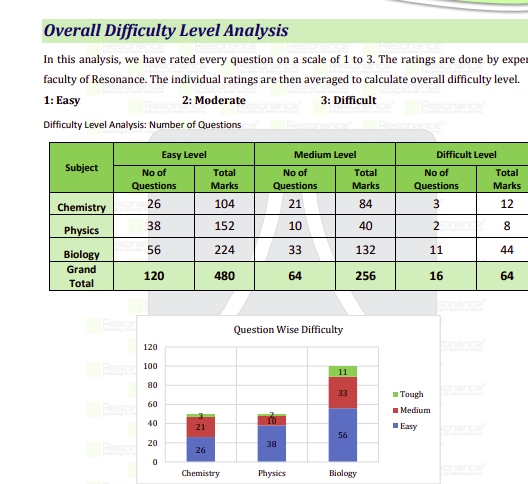
Difficulty Level Comparison from previous year papers
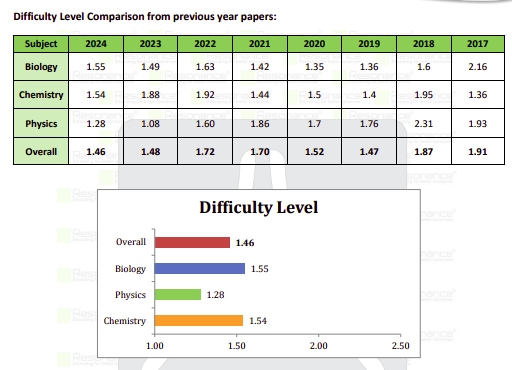
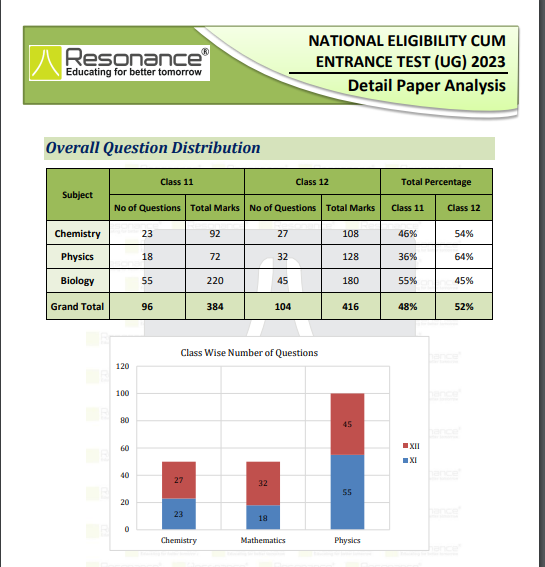
Difficulty Level Analysis: Number of Questions
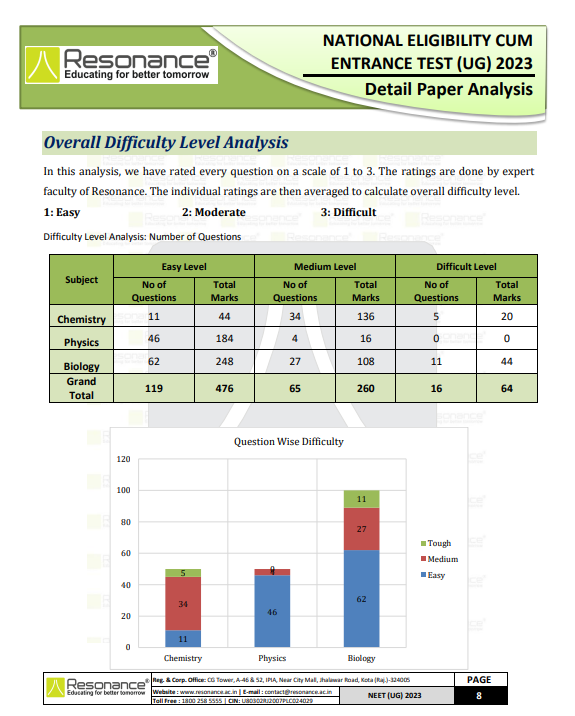
Difficulty Level Comparison from previous year papers
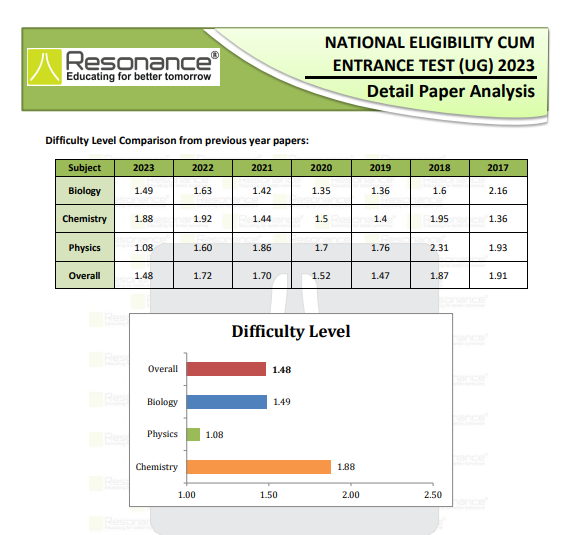
Overall the NEET 2023 paper was found to be easy to moderate and easier than last year's NEET 2022 paper. In Biology, the maximum questions were from NCERT and were found easy to moderate level but 11 questions were analytical hence they would be considered as tough. In Chemistry, around 35 questions from total 50 were from NCERT and paper was not so calculative. In Physics, almost all questions were formula / definition based and easier than last year. This year NEET paper contains straight line MCQ, assertion reason type questions, statement type questions, matching types questions. Also, all the subjects were easier compared to last year.
Since the paper is easy than last year, the expected cutoff should be increased and is expected to be around 610 for MBBS govt. seat for Gen. category for AIQ.
Read detailed analysis of NEET 2023 by Resonance
NEET 2022 analysis by Resonance
Difficulty Level Analysis: Number of Questions
Subject | Easy Level | Medium Level | Difficult Level | |||
No of Questions | Total Marks | No of Questions | Total Marks | No of Questions | Total Marks | |
Chemistry | 12 | 48 | 30 | 120 | 8 | 32 |
Biology | 49 | 196 | 39 | 156 | 12 | 48 |
Physics | 25 | 100 | 20 | 80 | 5 | 20 |
Grand Total | 86 | 344 | 89 | 356 | 25 | 100 |
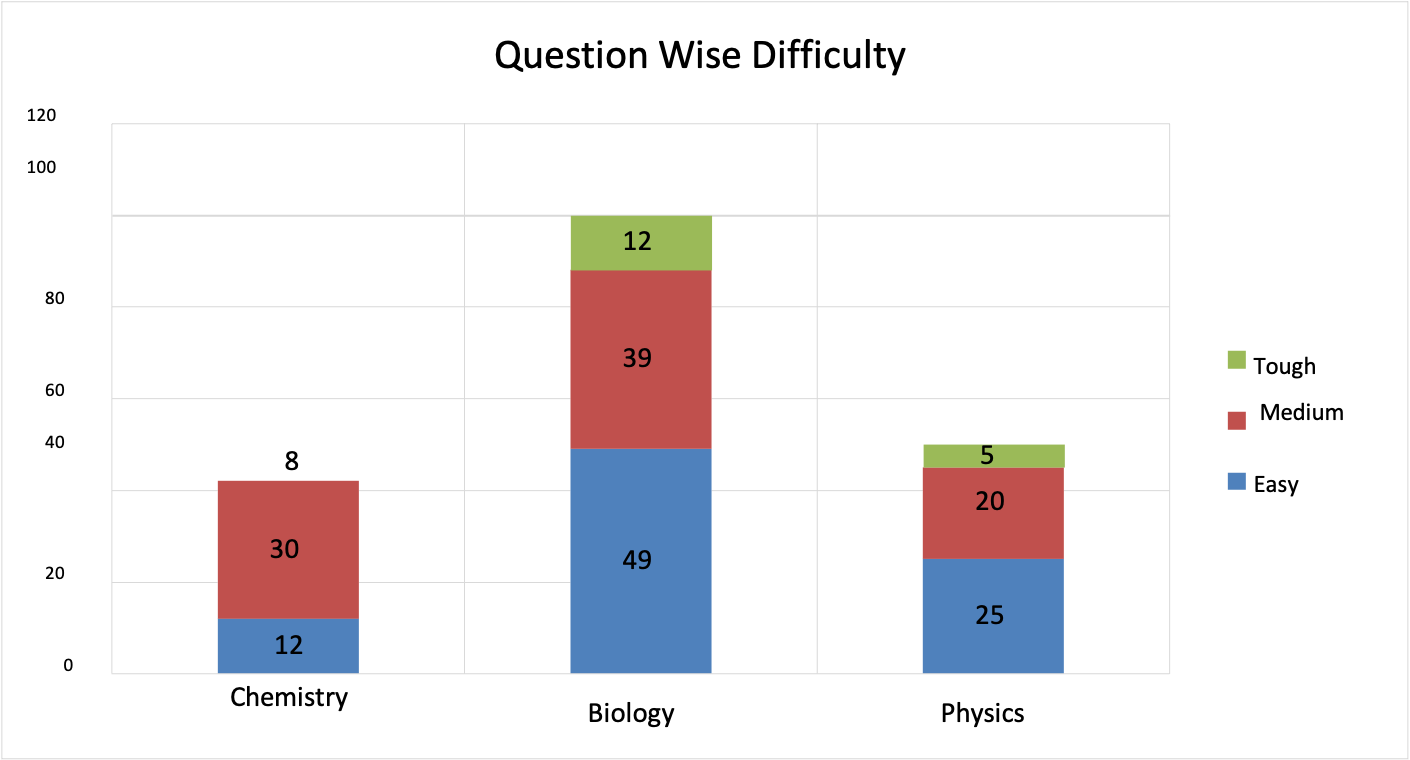
Comparably, the paper was easier than the previous two years.
Also, all the subjects were easier compared to last year.
Of the three subjects, Physics was comparatively difficult.
Biology and Chemistry were easy and of almost the same difficulty level.
Of the 180 questions: 113 were easy, 50 moderate and 17 were difficult
Of the three subjects, physics had a maximum of 9 difficult questions, followed by Biology at 7. Chemistry had a measly 1 question rated as difficult.
Questions in physics required fewer calculations compared to last year and were conceptually simpler.
Biology included a major chunk of questions from NCERT. There were 10 questions that were a bit tricky.
In Chemistry, 40 questions were from NCERT. Most of the questions required little to no calculation
As per the experts at Resonance, the paper this year was much easier compared to both 2018 and 2017. This is how they rated the difficulty level compared to previous years:
Subject | 2019 | 2018 | 2017 |
Biology | 1.36 | 1.6 | 2.16 |
Chemistry | 1.4 | 1.95 | 1.36 |
Physics | 1.76 | 2.31 | 1.93 |
Overall | 1.47 | 1.87 | 1.91 |
Here, denotation is like-1: Easy 2: Moderate 3: Difficult
If one looks at the charts by Resonance, it seems obvious that the overall difficulty level has been decreasing in the last few years. Subject-wise, Biology is getting easier, whereas the difficulty level of Chemistry and Physics continues to fluctuate.
Difficulty analysis
Subject | Easy Level | Medium Level | Difficult Level | |||
No of Questions | Total Marks | No of Questions | Total Marks | No of Questions | Total Marks | |
Physics | 20 | 80 | 16 | 64 | 9 | 36 |
Chemistry | 28 | 112 | 16 | 64 | 1 | 4 |
Biology | 65 | 260 | 18 | 72 | 7 | 28 |
Grand Total | 113 | 452 | 50 | 200 | 17 | 68 |
The number of questions asked from Class 11 and 12 is almost evenly matched, though if one looks at it closely it can be seen class 11 carried a little more weightage.
Subject | Class 11 | Class 12 | Total | |||
No of Questions | Total Marks | No of Questions | Total Marks | No of Questions | Total Marks | |
Physics | 22 | 88 | 23 | 92 | 45 | 180 |
Chemistry | 23 | 92 | 22 | 88 | 45 | 180 |
Biology | 46 | 184 | 44 | 176 | 90 | 360 |
Grand Total | 91 | 364 | 89 | 356 | 180 | 720 |
Aspiring medical candidates can go through the detailed subject-wise analysis of the previous year's NEET question paper from the table below.
Physics | No. of Questions |
Capacitance | 1 |
Centre of Mass | 1 |
Circular Motion | 4 |
Current electricity | 3 |
Electromagnetic Induction | 2 |
Electrostatics | 3 |
Error and Analysis | 1 |
Fluid Mechanics | 1 |
Geometrical Optics | 4 |
Gravitation | 2 |
KTG & Thermodynamics | 2 |
Magnetism | 3 |
Modern Physics | 3 |
Newton's Laws of Motion | 1 |
Properties of Matter | 1 |
Rectilinear Motion | 1 |
Relative Motion | 1 |
Rigid Body Dynamics | 2 |
Semiconductor Devices | 2 |
Simple Harmonic Motion | 2 |
Surface Tension | 1 |
Thermal Expansion | 1 |
Unit and Dimension | 1 |
Wave Optics | 1 |
Work Energy and Power | 1 |
Grand Total | 45 |
Chemistry | Number of Questions |
Aromatic Compounds | 2 |
atomic structure | 2 |
Biomolecules | 1 |
Carboxylic Acid Derivative | 1 |
Chemical Bonding | 3 |
Chemical Kinetics | 2 |
Chemistry in everyday life | 1 |
Coordination Compounds | 1 |
D Block | 1 |
Electrochemistry | 2 |
Environmental Chemistry | 1 |
equivalent Concept | 1 |
Gaseous State | 1 |
GOC | 2 |
Hydrocarbons | 2 |
Hydrogen | 1 |
Ionic Equilibrium | 3 |
IUPAC | 1 |
Metallurgy | 1 |
Mole Concept | 1 |
P Block | 4 |
periodic table | 1 |
Polymer | 1 |
Redox Reactions | 1 |
S Block | 2 |
solid state | 1 |
Solution and Colligative Properties | 2 |
Surface Chemistry | 1 |
Thermodynamics | 2 |
Grand Total | 45 |
Botany | Number of questions |
Anatomy Of Flowering Plant | 3 |
Biodiversity and Conservation | 3 |
Biological classification | 2 |
Cell Cycle and Division | 2 |
Cell: The unit of life | 5 |
Ecosystem | 1 |
Environmental Issues | 4 |
Genetics - I Principle of Inheritance and variation | 7 |
Genetics - II Molecular basis of inheritance | 3 |
Living World | 1 |
Microbes in Human Welfare | 1 |
Mineral Nutrition | 1 |
Morphology in flowering plants | 1 |
Organisms and Population | 1 |
Plant Growth and Development | 2 |
Plant Kingdom | 1 |
Respiration in Plants | 2 |
Sexual Reproduction in flowering Plants | 4 |
Transport in Plants | 3 |
Grand Total | 47 |
Zoology | Number of Questions |
Animal Kingdom | 2 |
Biomolecules | 4 |
Biotechnology and its application | 2 |
Biotechnology and its Processes and principle | 3 |
Body Fluids and Circulation | 2 |
Breathing and exchange of gases | 1 |
Chemical Coordination | 2 |
Digestion and Absorption | 2 |
Evolution | 3 |
Excretory products and their elimination | 2 |
Human Health and Disease | 4 |
Human Reproduction | 3 |
Locomotion and Movement | 2 |
Microbes in Human Welfare | 3 |
Nervous System | 2 |
Reproductive Health | 3 |
Strategies for Enhancement in Food Production | 1 |
Structural Organisation in Animal | 1 |
Structural Organisation of Animals | 1 |
Grand Total | 43 |
On Question asked by student community
Hello aspirant,
If you want information only about EAPCET and not NEET, follow the official EAPCET website and state counselling portal regularly. You can subscribe to EAPCET - specific notifications on education websites and turn off NEET alerts. On Careers360, search only for EAPCET pages and bookmark them for updates on syllabus, dates, counselling and colleges. This way, you stay focused only on EAPCET preparation and news.
FOR REFERENCE : https://engineering.careers360.com/exams/eapcet
Hope the details will help you.
THANK YOU
Hello aspirant,
This kind of name order difference between your Class 10 marksheet and Aadhaar is quite common and usually does not cause serious issues for NEET 2026 . While filling the NEET form, always enter your name exactly as it appears on the Class 10 marksheet, since it is the main reference document. During counselling, if asked, you can explain the difference and keep a simple affidavit or supporting ID ready to confirm both names belong to you.
Hope the details will help you.
THANK YOU
Hello
You can give NEET mock tests here:
Carers360 is provind free mock test the link is given below check your preparation:
Free Neet Mock Test-
https://learn.careers360.com/test-series-neet-free-mock-test/
Free mock test Pdf with solution-
https://medicine.careers360.com/download/ebooks/neet-ug-free-mock-test
I hope this information usefull for you
Best of luck for the Preparation
Yes , NEET material in hindi is available on careers360 website:
Books in hindi for Neet 2026-
https://medicine.careers360.com/hi/articles/best-books-for-neet
Syllabus Neet 2026-
https://medicine.careers360.com/hi/articles/neet-syllabus
Syllabus for NEET 2026-
https://medicine.careers360.com/articles/neet-study-material
Even we also have study plan for NEET 2026-
https://medicine.careers360.com/hi/articles/neet-study-plan
Kindly reffer to the above links for the information you have asked for and all the best for the preparation and exam.
Hello aspirant,
Students can finish their NEET preparation and pass the test with flying colors thanks to the mock exams. For NEET, NTA offers test papers and online practice exams. To assess their level of preparation, students must rehearse the exams. After completing the test, assess and analyze it to determine ways to raise your score.
To get the sample papers, you can visit our site through following link:
https://medicine.careers360.com/articles/neet-sample-paper
Thank You
Ranked as India’s #1 Not for profit pvt. University by India Today | Wide Range of scholarships available
NAAC A+ Accredited| Ranked #24 in University Category by NIRF | Applications open for multiple UG & PG Programs
Among top 100 Universities Globally in the Times Higher Education (THE) Interdisciplinary Science Rankings 2026
Amongst top 3% universities globally (QS Rankings) | Wide Range of scholarships available